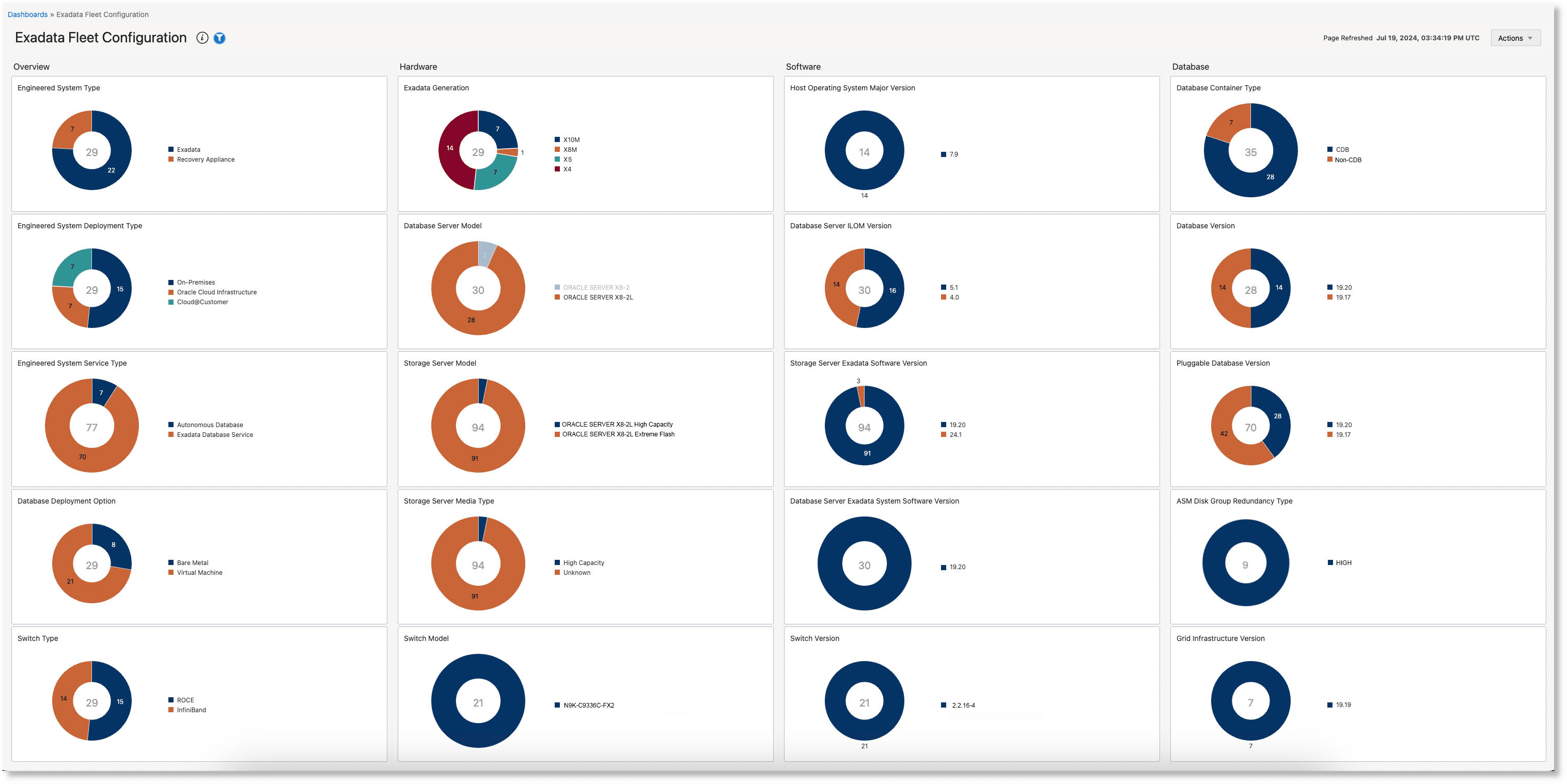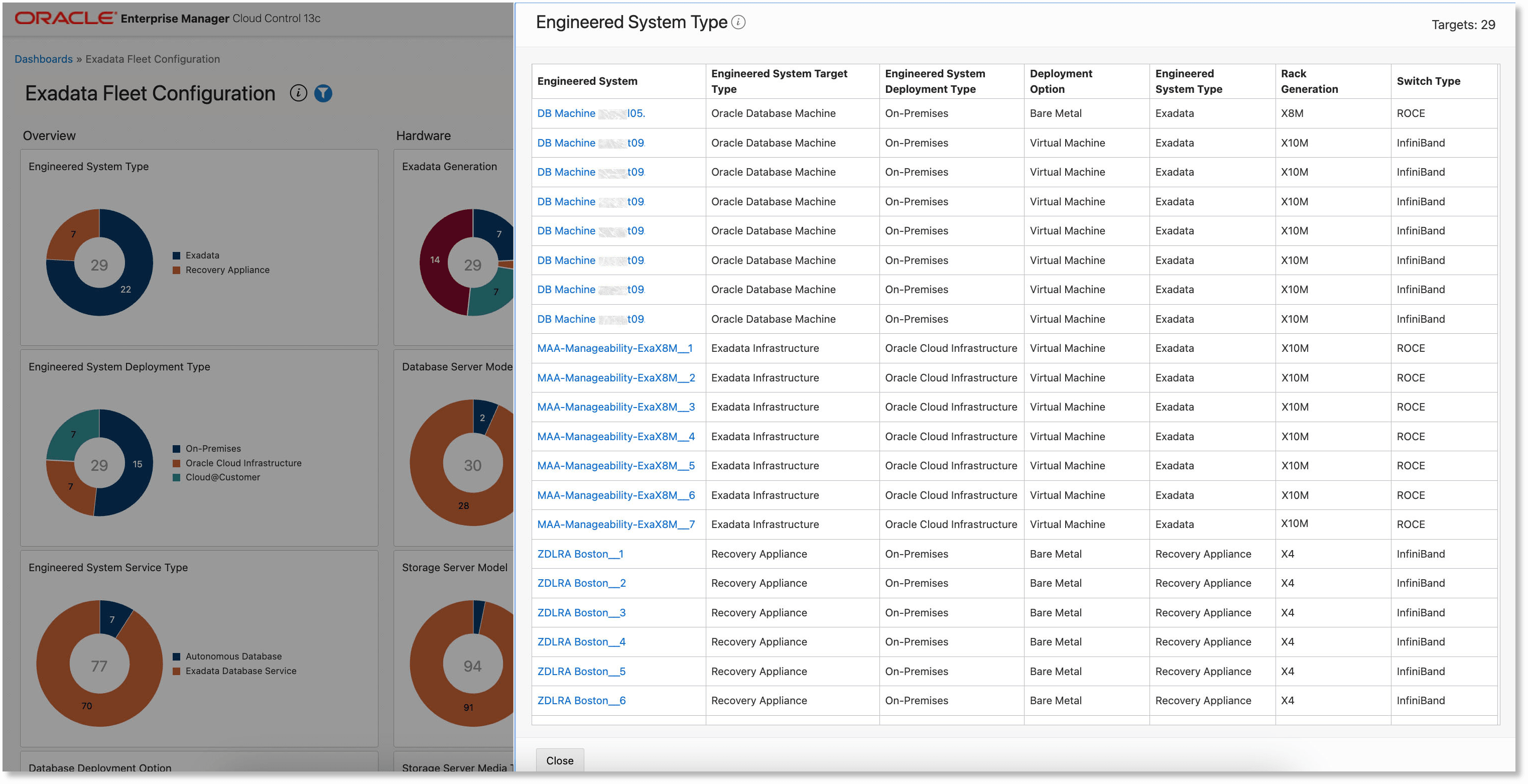Exadata Fleet Configuration
The Exadata Fleet Configuration dashboard shows the Exadata hardware and software configurations across the Exadata and Recovery Appliance fleet, based on the last known metric collection. You can apply the filters to limit the display to a subset of systems.

Click the numbers in the center of the ring charts or a ring chart section to see a detailed, in-depth breakdown of the dataset. The image below is an example of the details displayed when the number at the center of the Engineered System Type ring chart is clicked:

The Exadata Fleet Configuration dashboard has four vertical sections:
Overview
The ring charts in this section summarize the basic characteristics of the Engineered System fleet:
- Engineered System Type: The distribution of system types. Possible values are Exadata or Recovery Appliance. Exadata includes Database Machine and Exadata Infrastructure targets.
- Engineered System Deployment Type: The distribution of deployment types. Possible values are Cloud@Customer, On-Premises, and Oracle Cloud Infrastructure.
- Engineered System Service Type: The distribution of cloud service types across Exadata VM Clusters and Autonomous Exadata VM Clusters. Possible values are Autonomous Database and Exadata Database Service.
-
Database Deployment Option: The distribution of Exadata deployment options. Possible values are Virtual Machine and Bare Metal.
-
Switch Type: The distribution of network and management switch types. Possible values are Infiniband and RoCE.
Hardware
The ring charts in this section summarize key hardware characteristics of the Engineered System fleet:
-
Exadata Generation: The distribution of Exadata hardware rack generations; for example, X8-2, X7-2. Database Machines composed of multiple racks of different generations are categorized as Mixed.
- Database Server Model: The distribution of hardware models of the database servers; for example, Oracle Corporation ORACLE SERVER X7-2L High Capacity, Oracle Corporation ORACLE SERVER X8-2L High Capacity.
-
Storage Server Model: The distribution of hardware models of the storage servers; for example, X7, X8.
-
Storage Server Media Type: The distribution of storage server media types. Possible values are Extreme Flash and High Capacity.
-
Switch Model: The distribution of network switch hardware models; for example, N9K-C9348GC-FXP, Sun Datacenter InfiniBand Switch 36.
Software
The ring charts in this segment summarize key characteristics of the software running on components of the Engineered System fleet:
-
Host Operating System Major Version: The distribution of host operating system major versions; for example, 8.9, 7.9.
-
Database Server ILOM Version: The distribution of ILOM server major software versions; for example, 5.1, 6.1.
-
Storage Server Exadata Software Version: The distribution of storage server major software versions; for example, 26.1, 23.1.
-
Database Server Exadata System Software Version: The distribution of database server Exadata software major versions; for example, 24.1, 23.1.
-
Switch Version: The distribution of network switch software versions; for example, 10.3, 10.4.
Database
The ring charts in this segment summarize key characteristics of databases deployed on the Engineered System fleet:
-
Database Container Type: The distribution of container and non-container databases. Possible values are CDB and Non-CDB.
-
Database Version: The distribution of database release update versions for CDBs and non-CDBs; for example, 19.19, 23.5.
-
Pluggable Database Version: The distribution of database release update versions for pluggable databases; for example, 19.19, 23.5.
-
ASM Disk Group Redundancy Type: The distribution of ASM disk group redundancy levels. Possible values are High, Low, and Normal.
-
Grid Infrastructure Version: The distribution of grid infrastructure release update versions; for example, 19.19, 23.5.